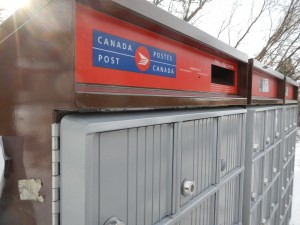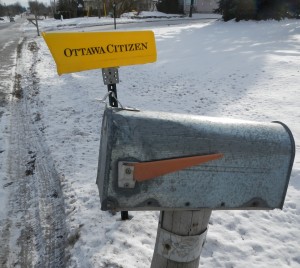Canada Post plans job cuts, rate hikes, end of door-to-door service

Moving city dwellers to community boxes – like these – would enable Canada Post to cut thousands of jobs. Photo: Lucy Martin
It’s no surprise that these are challenging times for governmental postal systems. Costs and competition are up. Volume and revenue are down. Setting economics aside, it’s also difficult to find consensus on what taxpayers want from a venerable – but fading – service.
So it was big news this week when Canada Post announced plans for rate hikes, elimination of urban door-to-door delivery and massive lay-offs (perhaps as many as 8,000). All this to be phased in over the course of the next five years. (Note: Since 1981, Canada Post has been something called a Crown Corporation, but for the sake of simplicity we won’t get into those nuances.)
If the cuts sound dismal, they can be phrased more positively. Here’s how the main Canada Post website worded the new business stategy:
Canada Post has released an integrated Five-point Action Plan that will form the foundation of a new postal system designed to meet the needs of busy Canadians. The implementation of this plan means Canada Post can return to financial sustainability by 2019. Read the Five-point Action Plan or view the Customer video.
You can read Wednesday’s full Canada Post press release here.
Opposition leaders criticized the announcement, and questioned its timing. In response, the Canadian Press reports that:
Transport Minister Lisa Raitt said her government supports Canada Post’s decision, noting it has had a mandate to operate on a self-sustaining basis since 1981. The Crown corporation says its five-point cost-cutting plan is aimed at returning the company to financial stability by 2019.
Canadians are sending fewer letters and parcels than ever, leaving Canada Post with no choice but to enact some tough financial measures in an effort to combat a steep decline in revenues, Raitt said.
A typical Canadian household buys only one to two dozen stamps a year, and mail volumes have continued to plummet, having fallen nearly 25 per cent per household since 2008, she added.
Of course union leaders were shocked and outraged. As reported by Kathryn May for the Ottawa Citizen, the Canadian Union of Postal Workers called it a “downward spiral.” Denis Lemelin, national president of CUPW indicated:
…he’s confident that Canadians will join the union’s campaign to stop Canada Post from phasing out home delivery and encourage the crown corporation to invest in new services to offset the steady decline of mail volumes.
“If this happens, it would be the end of an era for Canada Post,” said Lemelin. “We recognize that Canada Post needs to change, but this is not the way. CUPW has consistently advocated for innovation and service expansion to create a financially viable and service-oriented postal service for the future.”
Phasing out door-to-door delivery in cities would just mean more use of community mailboxes – clusters of locked boxes, currently used by an estimated two-thirds of rural and suburban customers across Canada. Despite that, this is still an emotionally-charged proposal, as recounted by Elizabeth Payne in supplemental reaction from the Citizen.
Wearing a red Santa hat and carrying two Canada Post mail bags strapped to his chest, Maurice Bertrand follows a well-trod path through the Glebe.
For more than a century, letter carriers like Bertrand have walked the streets of Ottawa’s oldest suburb through bone-chilling cold, heat waves, ice storms and rain, up the walkways of its houses and on to their front porches to deposit letters, parcels, cards, magazines and more into mailboxes and front door slots.
The Santa hat which Bertrand wears every December draws friendly comments as he makes his way along the route.
“I love my job,” he says — although he’s not so effusive about his employer today.
Some worry that so-called shut-ins and the elderly will lose the important benefit of a friendly face checking in on a regular basis. Others say using the community boxes is no big loss at all.
Media reactions includes an item from Post Media News reporters Jason Fekete and Andrea Hill raising questions about a possible conflict of interest at top leadership levels. Commentator Andrew Coyne said: “Ending Canada Post’s Monopoly would benefit taxpayers and consumers“. Fellow columnist John Ivison wrote: “Canada Post offers a band-aid solution to a problem requiring radical surgery.”
There’s other muttering in media and conversational circles about a rush to balance budgets through service cuts and attacks on public sector workers. In terms of political demographics, it’s also being observed that the changes will have a greater impact on urban Liberal/NDP voters.
Conversely, many consumers say they don’t need daily mail, or postal service at all. Email and the private sector can fill that gap.
Whatever camp you fall in, North Americans are facing some basic conversations about what we do or don’t need when it comes to this thing we call surface mail.
12/13 update: Writing this post yesterday, I made a mental note to go buy more “permanent” stamps. (The current rate of 63 cents for a first-class domestic mail stamp is set to rise to one dollar next March, or 85 cents if purchased as a pack. Either way, that’s a steep rate hike.) Well, apparently lots of people had the same thought. Sales of permanent stamps have been suspended.
Tags: canada, Canada Post, economics, politics, postal delivery








